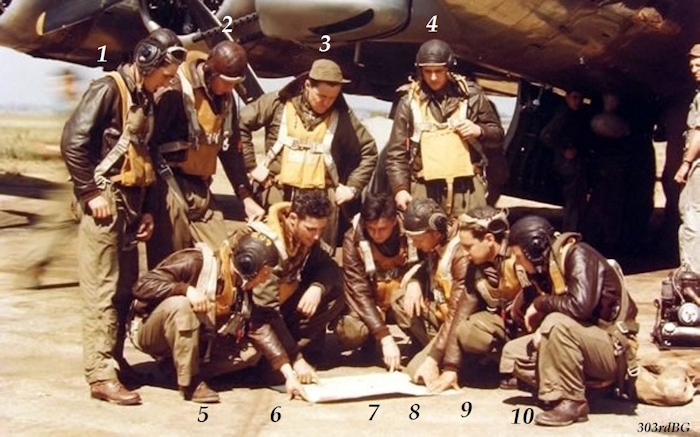 |
WWII Uniforms / Flight Gear Ed Nored Collection |
Personnel
Mission Reports
photos copyright ©2006-2018 by Ed Nored, used by permission
Flight Gear 1944-1945 / F-3 Heated Suit
Parachutes 1943-1945
Displayed below are several examples of opened and unopened parachutes used by fighter pilots and bomber crews.
Finding authentic examples of such parachutes is getting harder then ever. One company that specializes in accurate, top quality reproduction parachutes and flak vests is THE RIGGER DEPOT by Joshua DeJong. His reproduction parachutes and flak vests are fantastic — and they are Made in America. Please visit his website and see how they "Bring History to Life." This is an unsolicited, uncompensated endorsement. His products speak for themselves. ~ Ed Nored. |

Shown above is an official photo taken on January 6, 1943 at the National Automotive Fibres company. Well over 150 women are seen of all ages making parachute canopies. Thousands of airmen's lives would be saved and thousands of airborne infantry and supplies will be safely delivered thanks to these ladies. On the back walls patriotic posters can be seen. "Every Minute Counts!" and "Chute for Victory!" (click image for a larger view)
THE B-7 PARACHUTE AND RAF OBSERVER TYPE HARNESS AND PARACHUTE
ARE SHOWN ON THE FLIGHT GEAR 1943 PAGE
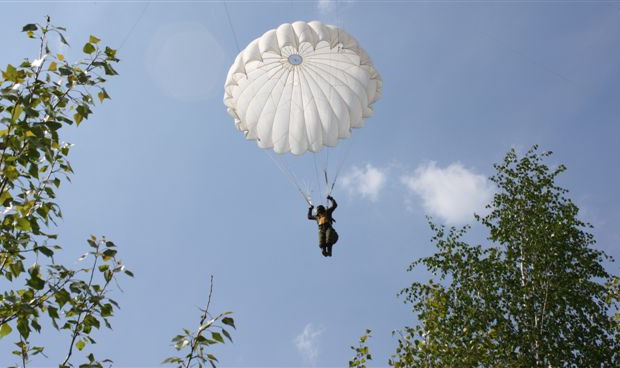
(7-1) The scene depicted above is typical of the 1000's of bomber crews and fighter pilots who bailed out during the war. No telling what fate awaits him once he lands. After learning about flight gear and parachutes in this Uniform / Flight Gear section, don't miss out on the many dramatic bailout stories told here on this site.
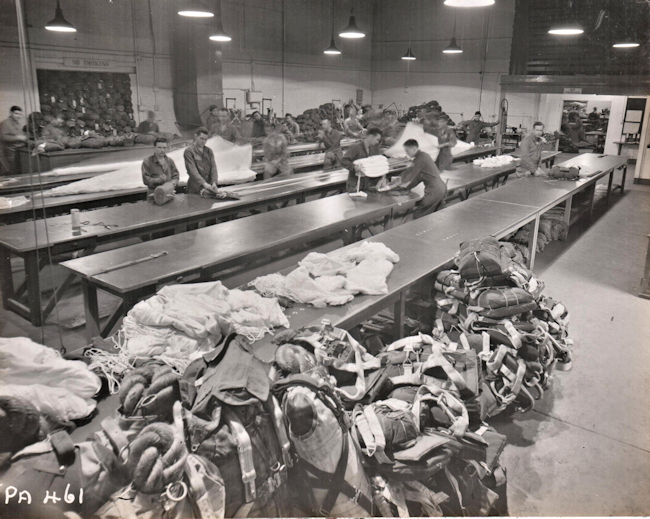
(7-2) Shown above and below are two photos showing the parachute shop at Burtonwood, England, Depot 1. Hundreds of parachutes can be seen in the photos. Seat-pack, back-pack and Quick Attachable Chest parachutes are present. In the foreground a drop test dummy with an OD A-3 harness is present. On the tables parachutes can be seen in various states of packing.
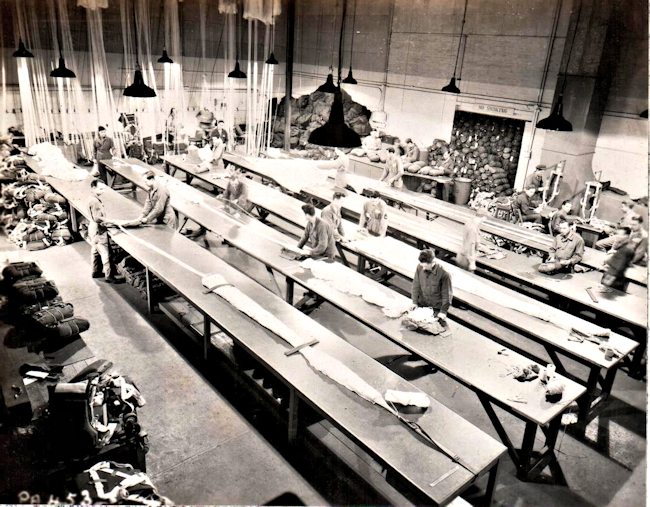
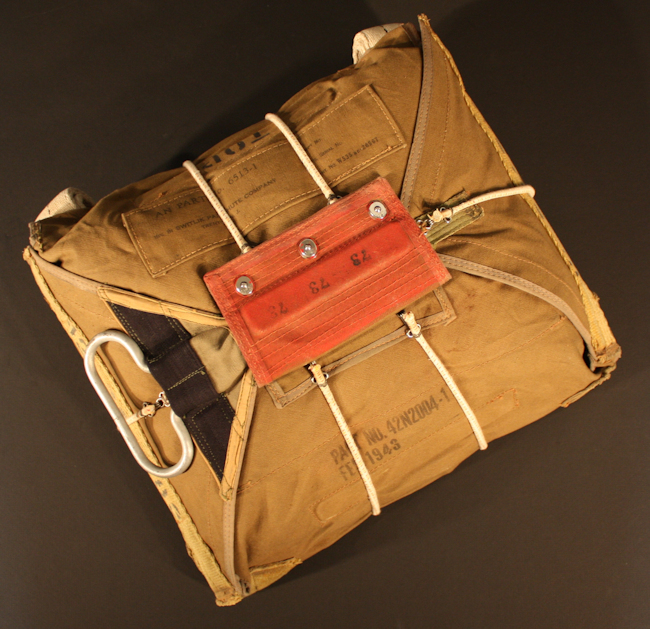
(7-3) Shown above and below are examples of the Q.A.C. (Quick attachable chest) parachute 6513-1, dated Feb. 1943. Its manufacturer is the Switlick Parachute Company, Trenton New Jersey.Shown below you can see a white stenciled tag declaring the chute is from the Navigator's Pool of equipment. The large hooks used are the same type used on the A-3 harness and the AN-6513 1-A parachute. Though this parachute came with an authentic WWII era log book, there was some information inside that didn't match this parachute.
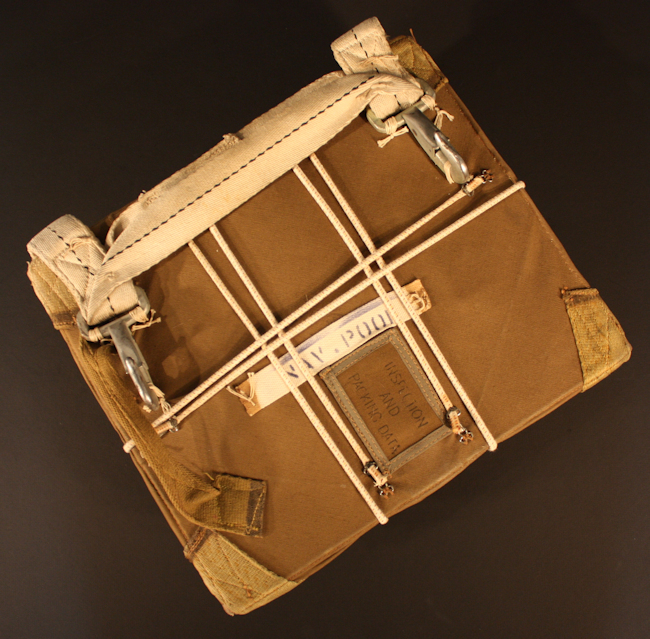
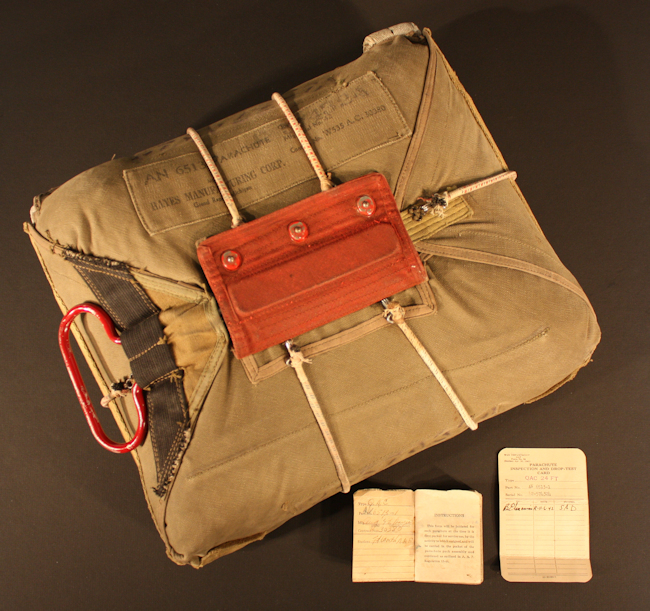
(7-4) Shown above and below is the second example of the early 6513. This AN 6513 was made by the Hayes Manufacturing Corp., Grand Rapids, Michigan in 1942. The original log book is shown in the photo as well as a "Parachute inspection and Drop-Test Card" dated 11-6-42. The log book refers to the pack as a AN-6513-1. Service at the Ft. Worth AAF is noted as one of its stations. This example, like the one above, was acquired without a parachute.
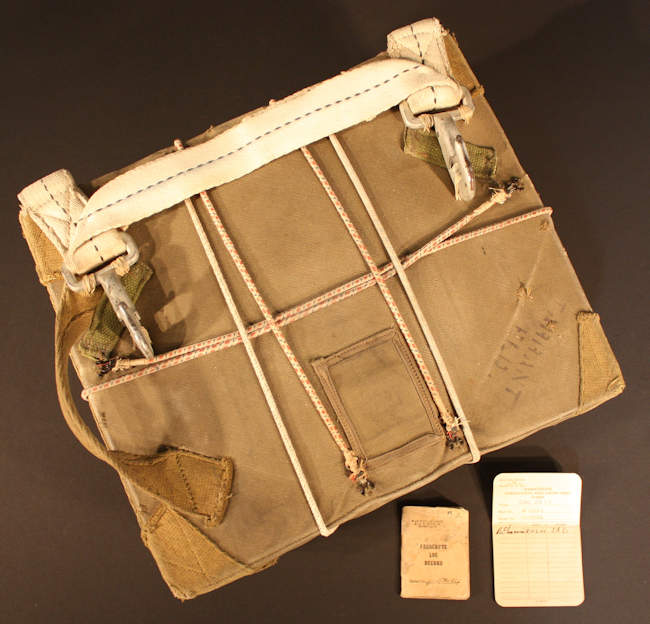
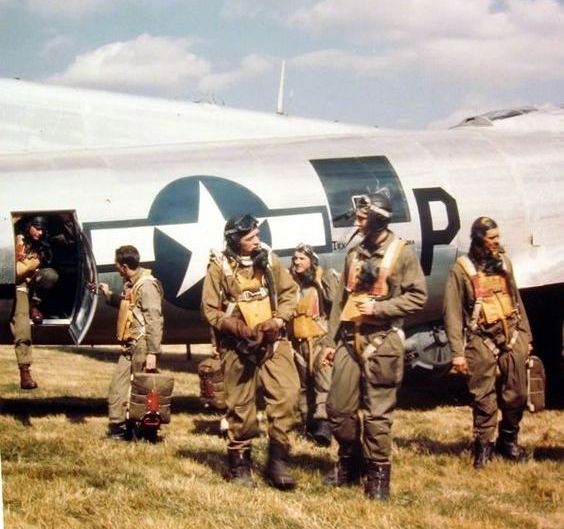
(7-5) Shown above is a crew of the 91st. BG exiting their B-17. Two of the parachutes seen are the AN-6513-1. There is one AN-6513-1A and 1 B-8 backpack seen. Other items seen are the A-14 oxygen mask, B-8 goggles, A-11 helmets, A-4 and 6550 flight suits and of course, A-6 boots.

(7-6) Shown above is a great shot of a crewman who has just bailed out from his B-17. Though the photo is of poor quality, the small pilot chute (the term pilot chute has nothing to do with the pilot of the airplane) can be seen just above the larger canopy. The small pilot chute's job is to catch some air and help drag out the main canopy. In this photo the canopy is quickly filling with air and, in another second or two, will blossom full. The crewman will swing down below the canopy and all will go quiet as the roar of his B-17 grows faint. He may begin to look around to see if the rest of his crew gets out and maybe even see his plane crash. We can tell it is a QAC (Quick Attachable Chest) type of harness because the suspension lines "funnel" right back to his chest. It is either the AN 6513 1A or the A-3 harness, who's risers haven't yet broken loose.
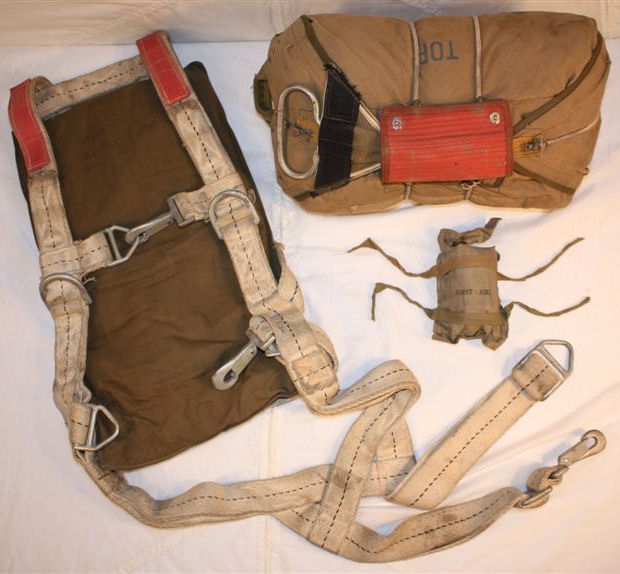
(7-7) Shown above is the AN-6513 1A parachute with its harness and a parachute first aid kit. All three items, since the end of the war, had been stored in an old "Old Taylor Straight Bourbon Whiskey" box dated 1946. It is very rare to find such an untouched grouping.

(7-8) Above is a closer look at the first aid kit with the standard three items found in the parachute first aid kit. One small Carlisle bandage, one tourniquet, and one Morphine syrette and the yellow box it came in. Every parachute harness had one of these kits tied onto it – nNo matter what type of parachute harness it was. If you find or have one of these rare kits, you will decrease the value of it by at least 60% if you open it.
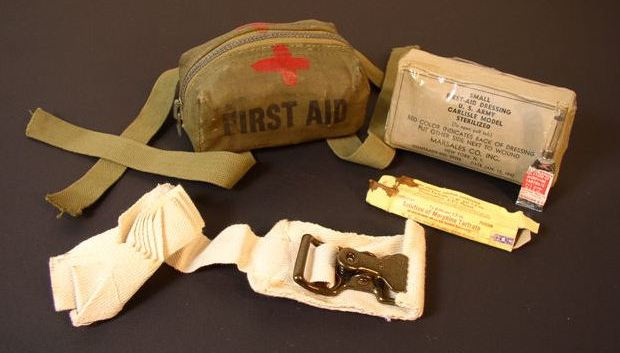
(7-9) Shown above is the "zippered parachute first aid kit." At least that's the way I describe it. I do not know if it's British made or American made. I do know it was definitely worn by ETO bomber crews early on and more so by the ETO fighter pilots later on. Shown above are the authentic items removed from the kit including an original Morphine injection. Most examples here on the 303rd BG site show up in Lead Crews during the 1943 period. See Lead Crew Mission # 51. Butt, Sink and Jessie are wearing one. Also see Goolsby and Bumgardner on Lead Crew mission #130. Another bomber crew wearing the first aid kit is the 358th Marshall L. Smith crew. The best photo of the zippered first aid kit is in the "Dressing for a Mission" Photos.
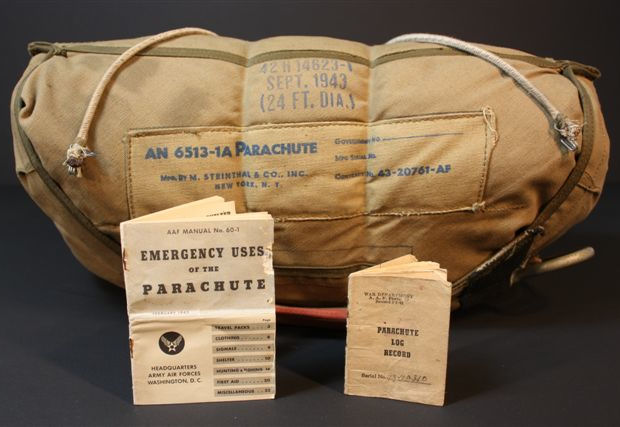
(7-10) Shown above is the side view of the 6513, manufactured by M. Steinthal and Company. The two small books shown are: (left) a manual giving a downed crewmen tips on how he can utilize his parachute to survive any of the harsh environments he may encounter after bailing out, and (right) is the log book. Every parachute pack had its own log book.

(7-11) Above you can see the two large hooks that fasten to the chest D rings of the harness. If you were wearing the harness, you would clip on the chute from the bottom just as the chute is positioned above. On the yellow group A-3 harnesses, these identical type hooks were used, placed at the end of the risers. The Parachute Log Record is opened showing varied typed entries. On these particular pages the parachute riggers initials "J.B." are noted, as well as where the base or station repairs took place. In this case KAAF is Kingman, Arizona airfield. Examples of abbreviated repairs noted are, "Inspection of Rip Cord Pins" and "Inspection of nylon suspension lines." Also note the small pouch between the hooks where the two books were stored.
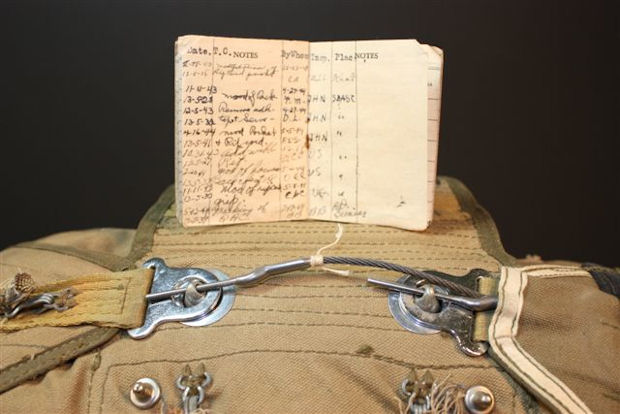
(7-12) Shown above you can see the rip cord pins that lock the four flaps down that enclose the parachute. Once you pull the rip cord, the rubber bungie cords are there to help open the flaps to allow for a cleaner deployment of the parachute. A different page of the parachute log record shows another group of entries. One entry shows "marking of QAC." This may refer to painting the outer cover red. Another entry includes work done to the harness as well as a modification of the rip cord pocket.
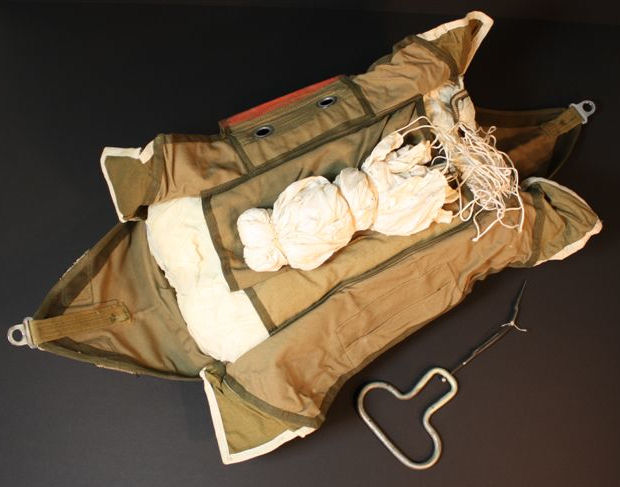
(7-13) Once the rip cord has been pulled, the bungie cords or elastic bands pull the flaps open. The pilot chute pops open and catches air and, as mentioned earlier, helps pull out the main canopy. In the photo above I have placed rubber bands around the pilot chute to show its normal position when the pack is closed.

(7-14) Shown above you can see the opened pilot chute as well as the main canopy still folded quite nicely. Note how the suspension lines are still folded and tucked away. The suspension lines have to be correctly packed in a particular order to insure a clean opening. As a crewman falls from his airplane, he has to assume the correct body position before opening the chute. In many cases men bailing out of bombers and fighters opened their chutes too soon only to have the canopy open and get caught on the tail of the airplane. In other cases they opened it while being in the wrong body position and the canopy and suspension lines wrapped around, or got entangled with, the mans legs.
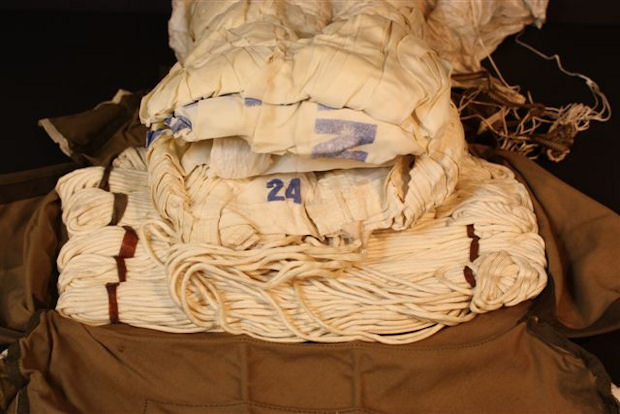
(7-15) Shown above are the groups of suspension lines still neatly stowed in place. Most of the rubber bands are still present. Looking at the end of the folded parachute, you can see two items stamped in blue ink. The "N" is one half of the "AN" stamp found on the parachute. It stands for Army Navy. The parachute is made of 24 panels sewn together and at the lower part of the canopy just above the skirt, each panel is numbered 1-24 for a 24 foot diameter parachute. Shown above is panel number 24.
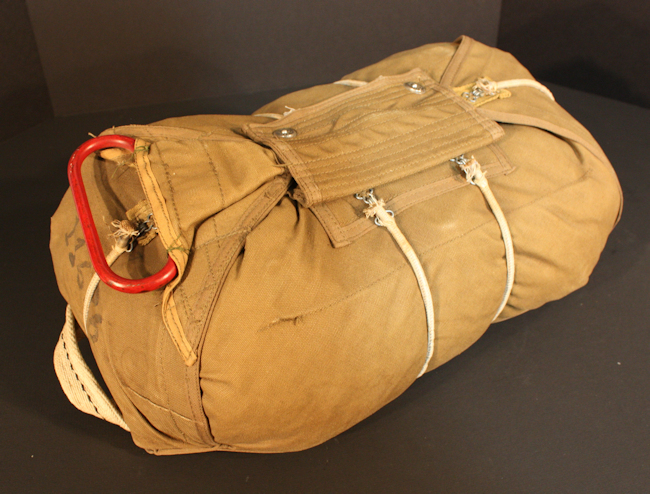
(7-17) Shown above and below is a beautiful all original AN-6513-1A that I'm fairly certain had a nice quiet civilian life. No military log present, and was purchased with the Vanity Fair harness shown below in photos 26, 27 and 28. Both came in the same parachute bag. This parachute was made in Aug. 1943 by the Vanity Fair Comp.


(7-19) Shown above and below is the Hayes AN 6513 1-A made in Aug. 1943. Showing service at 59th Sub Depot Lowry Field and other entries in log mention SAAAF (BS) Texas.
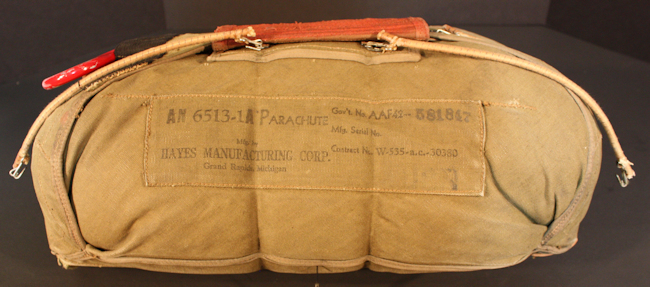
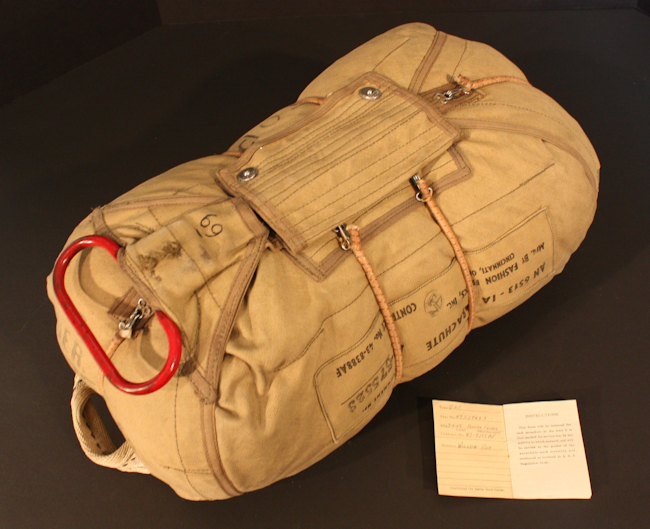
(7-21) Shown above and below is a AN-6513 1-A made by Fashion Frocks of Cincinnati, Ohio. Made July 9, 1943. Log book states Willow Run was its station. (The canopy was missing from this container and I had to furnish an original WWII canopy for it. Bob Bashaw did the work.)
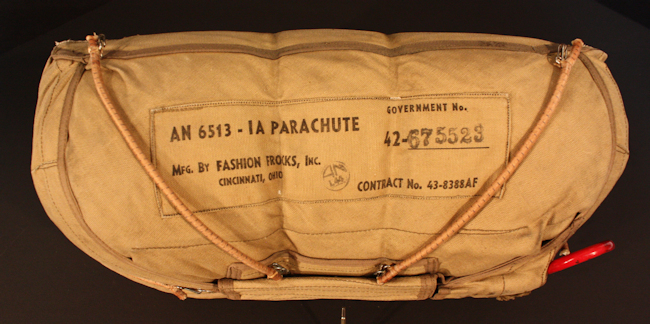
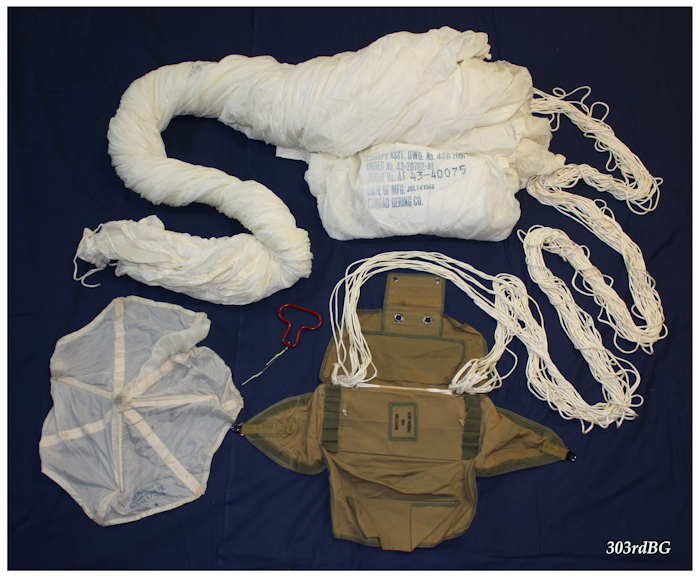
(7-XX) Shown above is another great example of a complete and original AN-6513-1a QAC (Red Group) parachute. This one is made by the CONRAD BERING COMPANY OF HOUSTON TEXAS. No log book is present. Shown below are the various I D markings found on this and all parachutes.
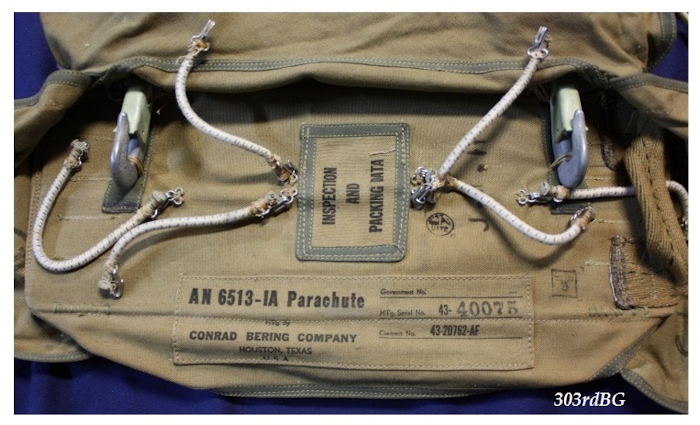
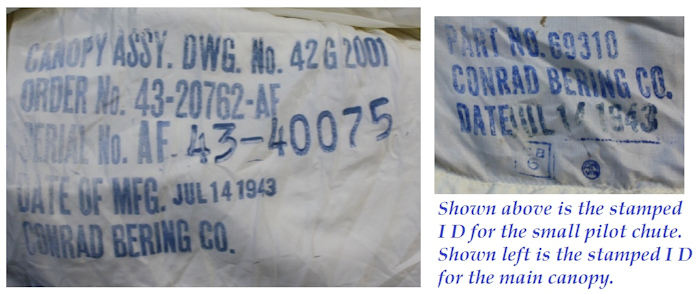
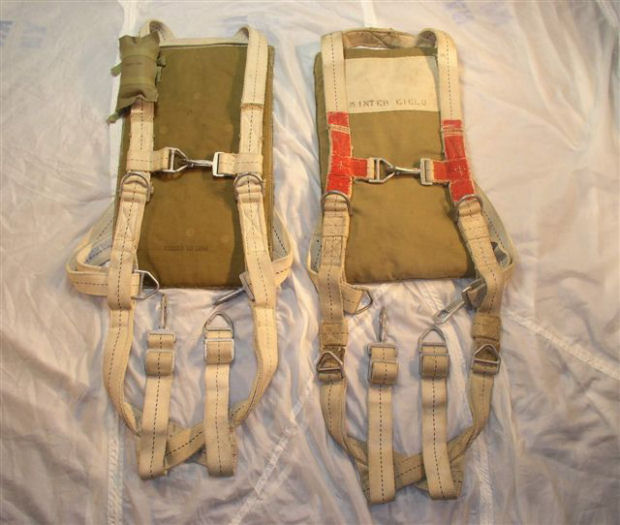
(7-23) Shown above on the left is an un-issued AN6513-1A Q.A.C. (quick attachable chest) harness. On the right a veteran brother of the same type. To see an example of a red marked QAC harness as shown above, see the lead crew mission #240. The crewman at the back, left is wearing the marked harness over his F-2 heated suit.
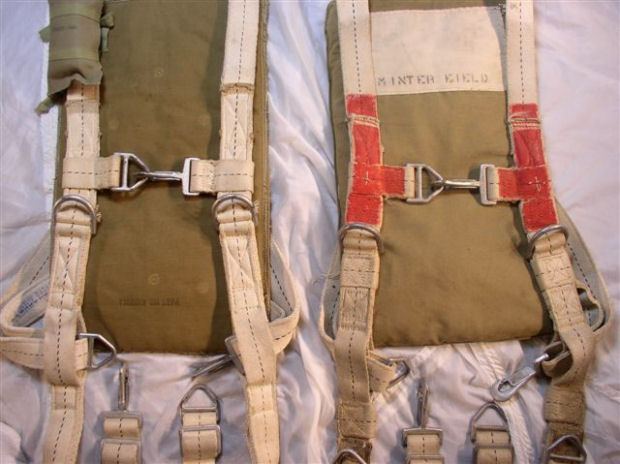
(7-24) Shown above is a closer look at the additional webbing and tacking applied to the harness on the right. Note the addition of the two D-rings added to accommodate the life raft container at the bottom of the harness. The piece of white material sewn onto the back pad was used to indicate the pilot's name and/or the air field it was from. It's rare to find this example, so consider its presence the exception and not the norm for the thousands of harnesses that were issued to the men of the 8th and 15th AAF overseas.
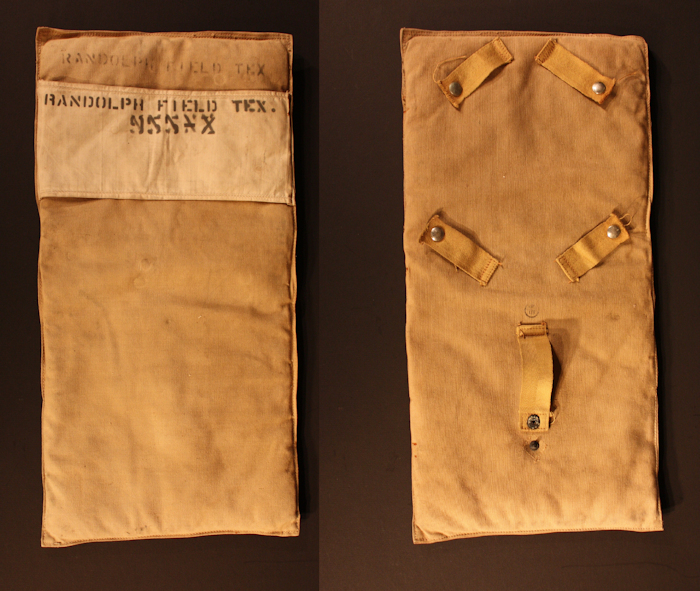
(7-25) Shown above, front and back, is another example of the 5 strap back pad used on the AN6513 and A-3 harness. It is showing service at Randolph Field Texas.
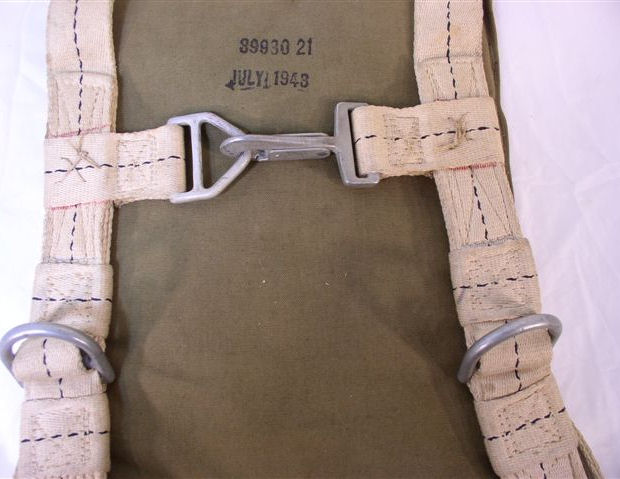
(7-26) Shown above is a closer look at the red group QAC harness that the AN 6513 1a parachute connected to. Each man who was issued his harness would have tried the harness on. Then a person from the parachute department would have "tacked down" his chute for a snugger or more perfect fit. The harness shown above and below was recently obtained and still has its original "tacking" from the last person who used it. The red markings or lines you see were placed there by the parachute rigger while the pilot or crewmen wore the harness. Upon removing the marked harness, the rigger used a strong twine and a needle and placed the straps where marked, then secured or "tacked" them down.

(7-27) Shown above are examples of where the leg straps have been "tacked down."
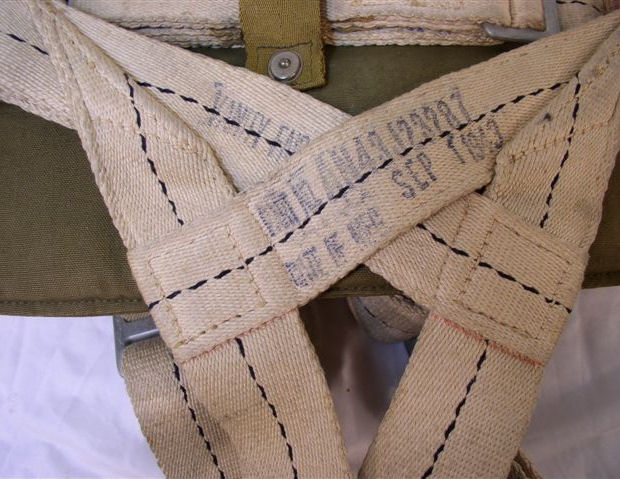
(7-28) Shown above is the manufactures stamp. Vanity Fair is the manufacturer and it was made Sept. 1, 1943. Vanity Fair also made parachutes.
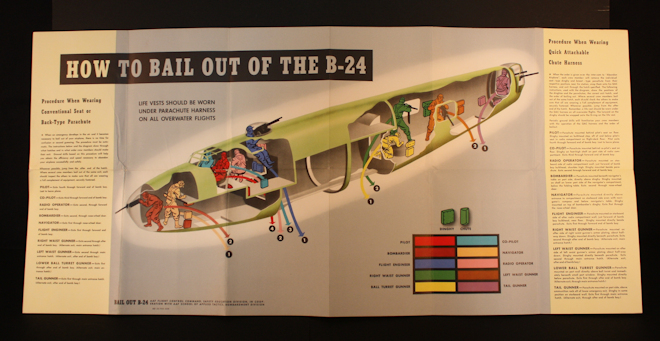
(7-xx) The authentic WW 2 poster above measures 20X42 inches. There are no dates that I could find. The poster refers to the correct location of where an individual's Dinghy (Life Raft) should be placed. The posters originate from the "AAF, Flight Control Command, Safety Education Division, In Cooperation With AAF School of Applied Tactics, Bombardment Division." (Click the image for a larger view.)
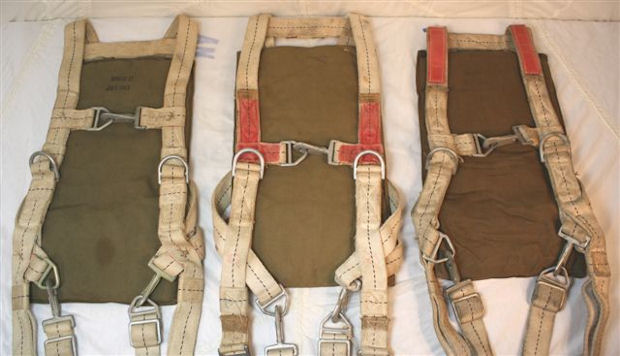
(7-xx) The Red and Yellow marking of the various harnesses began when AAF HDQ issued Technical Order 13-5-39 in May of 1944. Shown above and below are examples of the markings applied to the harnesses. In Sept. 1944 the TO was amended and the location and method of applying markings changed. In the above photo we see 3 examples of the AN6513 harness. The harness on the left is unmarked. The harness in the center has been marked red, complying with the May T.O. The harness far right complies with the Sept. 1944 amendment. I have never seen an 8th AF AN6513 harness marked this way. I have seen several photos of 15th AAF crew wearing harnesses with the Sept. 1944 required markings.
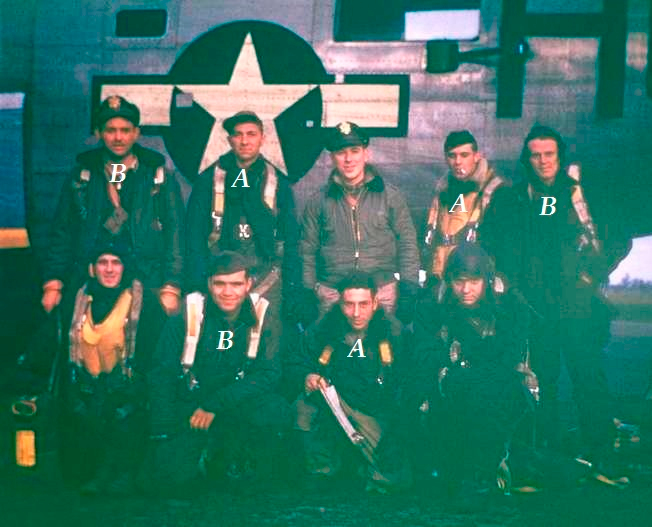
(7-xx) This color shot of a 453rd BG B-24 crew show the very late war yellow markings for the A-3 harness. The men with A on their chest have markings complying with T.O. of May 1944. The men with the B have markings required in the Sept. 1944 TO amendment. This photo was taken in April 1945. In my opinion, if I had an unmarked A-3 or AN-6513 harness, I would not mark it.
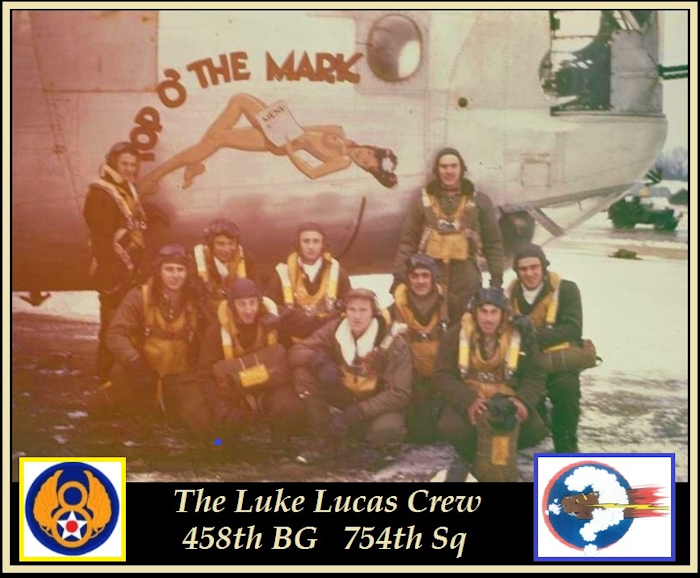
(7-xx) Shown above is a 458th BG/754th Sq crew displaying another excellent example of yellow markings (paint) on the A-3 harness and A-3 parachutes.

(7-xx) The authentic WW 2 poster above measures 20X42 inches. There are no dates that I could find. The poster refers to the correct location of where an individual's Dinghy (Life Raft) should be placed. The posters originate from the "AAF, Flight Control Command, Safety Education Division, In Cooperation With AAF School of Applied Tactics, Bombardment Division." (Click the image for a larger view.)
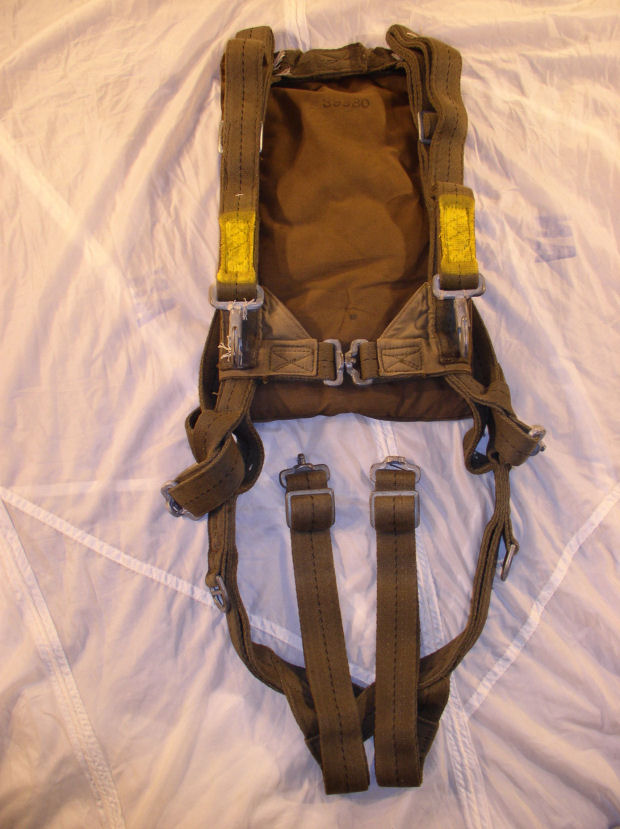
(7-29) Above is the A-3 harness constructed with olive drab webbing. On each side of the leg straps of all the A-3, red group, QACs and B-8 chute harnesses you find 2 "D" rings. They are there to attach to the C-2 type one-man life raft/dinghy.
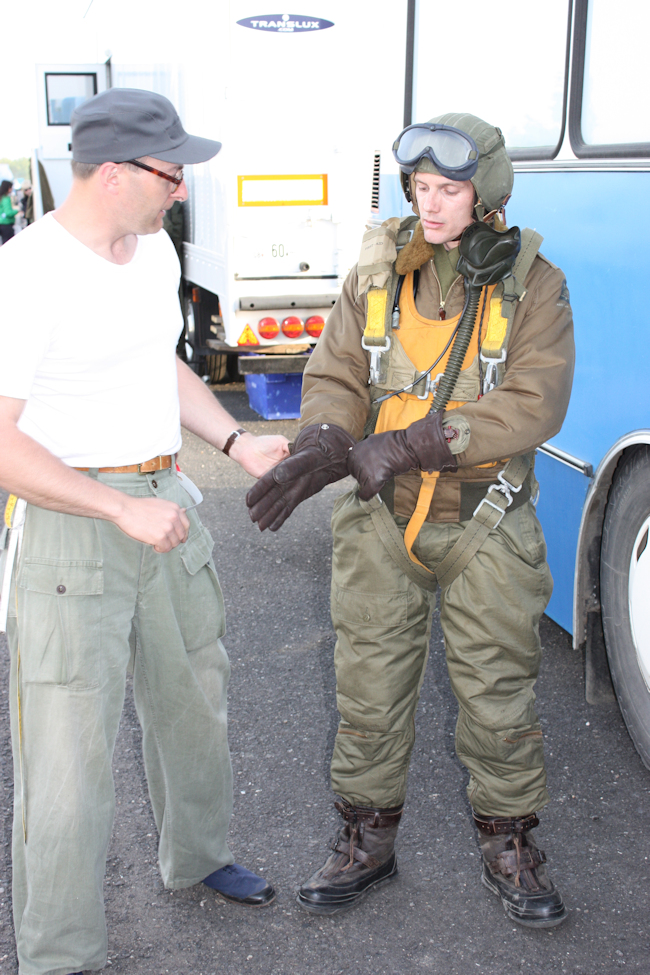
(7-xx) Andrew Fletcher assists actor Rick Otto in dressing the part of a late war B-17 pilot. You can tell by the connector at the wrist, Mr. Otto is wearing an authentic F-3A heated suit, A-11helmet, with A-14 mask. The flak helmet is most likely the M-4A2 with B-8 goggles on top. I loaned them my OD A-3 harness. (The same one shown above) complete with first aid kit . The Mae West is authentic also.The only piece's of flight gear that are not authentic are the reproduction A-6A boots and B-10 jacket. (Red Tails photo by Ed Nored, Copyright © Lucasfilm)
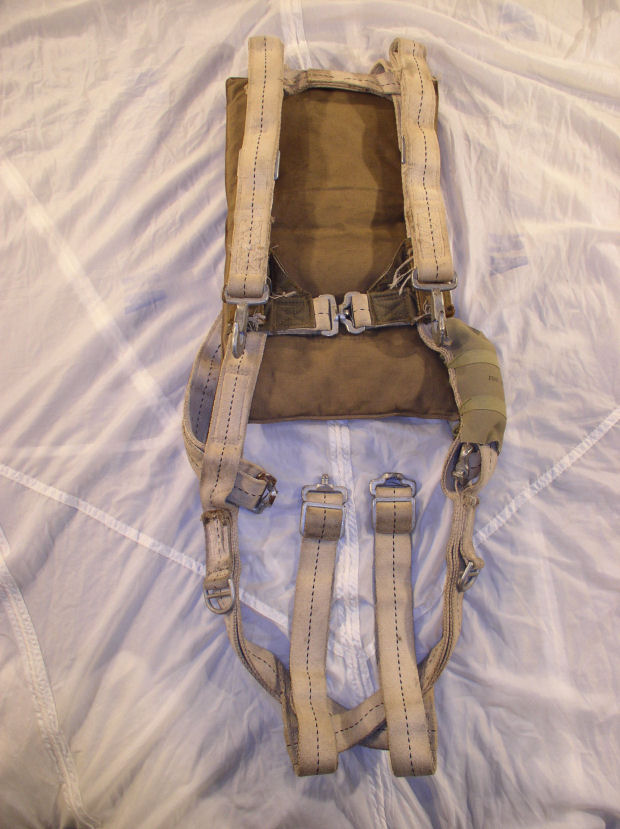
(7-30) The A-3 harness.
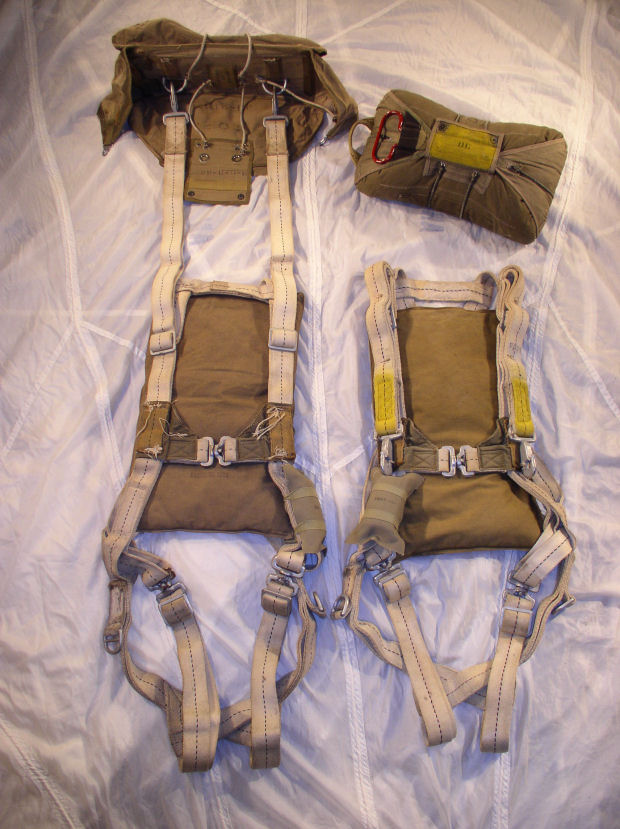
(7-31) Above are two authentic WWII, A-3 type QACs. The harness on the right still has its risers tacked down. Once a man connects the chute, bails out and pulls the rip cord, the force and weight of the man acts against the opening shock of the canopy. This sudden jolt pulls and breaks the tacking, allowing the parachute container and risers to be in the position you see above on the left. One veteran described how, after the canopy opened he was relieved, but thought he was falling out of his harness when the risers popped free a few seconds later.
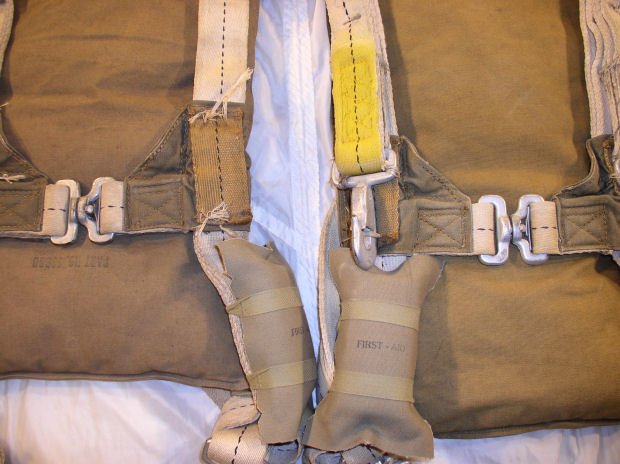
(7-32) vvvv vvvvvvvvvvvvvvvvv

(7-xx) Andrew and Ali struggle to make adjustments to the M-3 flak helmets head bands as one the actors playing a bomber crewman stands by. He is wearing the same flight gear as Rick Otto, described above. His A-3 harness is a reproduction from Bashaw. I did the yellow marking and first aid kit. (Red Tails photo by Ed Nored, Copyright © Lucasfilm)
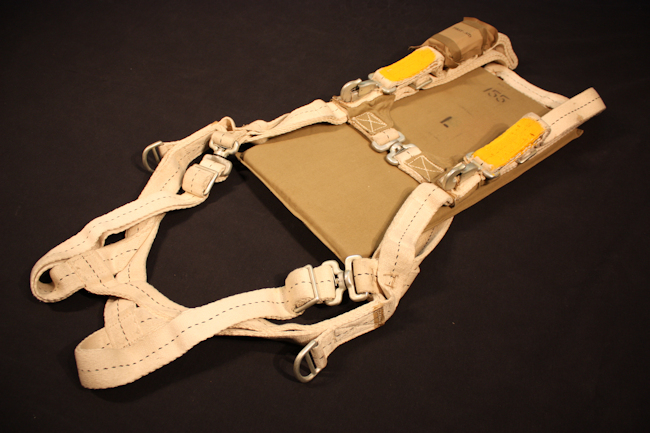
(7-33) Shown above is a beautiful A-3 made by the Campbell Comp. Dated Dec. 16, 1943.

(7-34) Shown above and below is the A-3 parachute made by the Atlantic Rayon Corp. dated Sept 22, 1943. No military log book. ( Sent to Bob Bashaw for repack and inspection. Canopy inside is dated Nov. 43 mfg. Atlantic Parachute Corp. serial # 811498. Canopy in excellent condition)
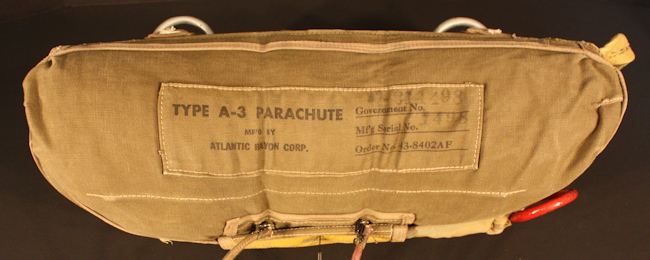
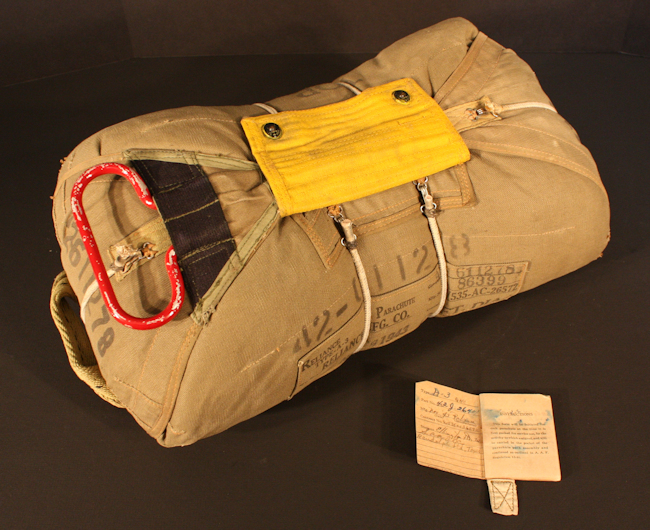
(7-36) Shown above and below is the A-3 parachute made by Reliance MFG.CO. Nov. 29, 1943. Original log book has typical maintenence entries and stations mentioned were Ellington FLD, Texas and Randolph FLD. Texas.
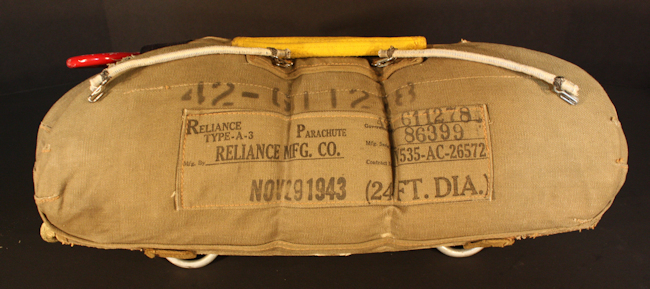

(7-38) Shown above and below is another A-3 made by the Reliance Mfg. Co. dated Feb. 10, 1944. Has original log and parachute. Sent to Bashaw for repack. Canopy in excellent condition. serial # 42-821716 Mfg. Reliance. Pilot chute made by Eagle parachute Co./1/44 dated. Station on log book only mentions O.C.A.S.C. # 582.


(7-40) Shown above and below is the A-3 parachute made by the Simmons Comp. Dated Sept 22, 1943. Has original parachute with original log book. Sent to Bashaw for repack and inspection. Canopy in excellent condition. Serial # 43-4275. Station mentioned on log is BAAF sub post Waco, Texas.
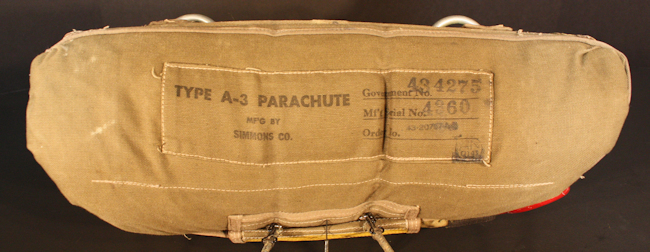
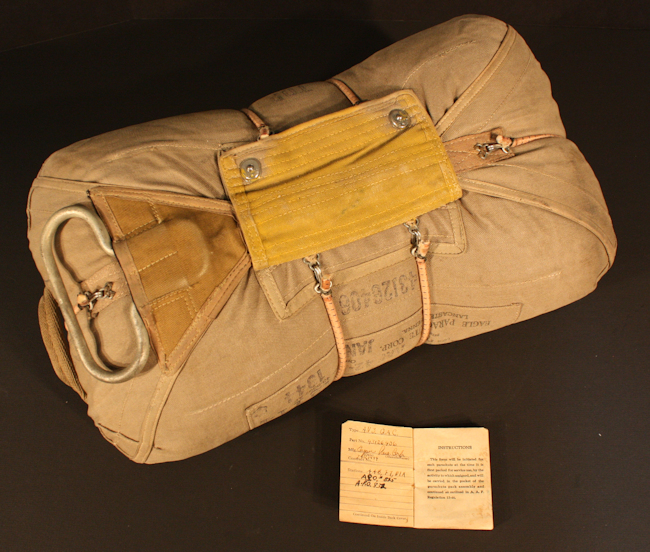
(7-42) Shown above and below is another example of the A-3 parachute. Made by the EAGLE PARACHUTE CORP. Lancaster Penna. Made Jan. 44 (no day date). Parachute is all authentic and complete with original log. Ft Dix is mentioned. This is the only example I've ever seen from this company.
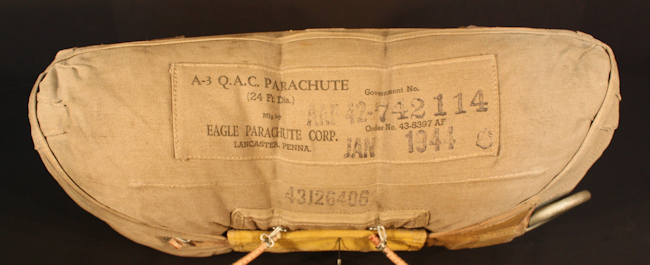

(7-44) Shown above is the Eagle A-3 pack opened up so you can see the interior components. What you see is what basically all of the parachutes contain. The stampings on the main canopy and pilot chute read Eagle Parachute Corp., both dated Jan 1944.
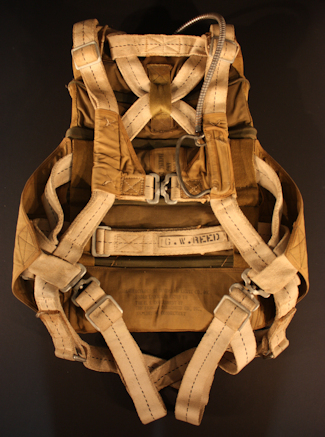
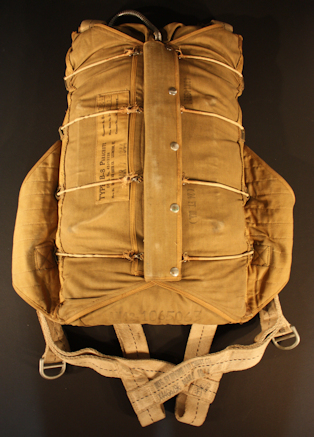
(7-45) vvvvvvvvvvv
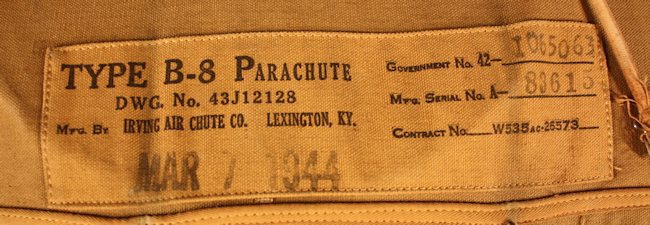
(7-46) vvvvvvvvvv
 ;
;
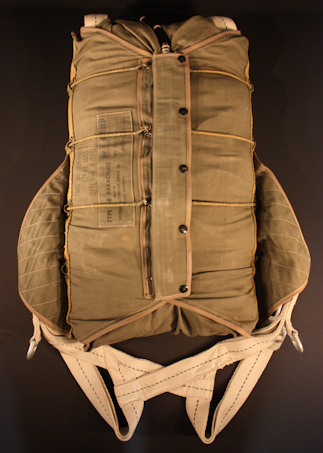
(7-47) Shown above is a near mint example of the B-8 parachute. It was made by the National Automotive Fibres Inc. January 4th, 1944. The B-8 showed up on the front lines of the 8th AF in about December of 1943. The B-8s with the snap hook and D-ring type of hardware always has a small cushion or pad affixed to the hook that connects at the chest.
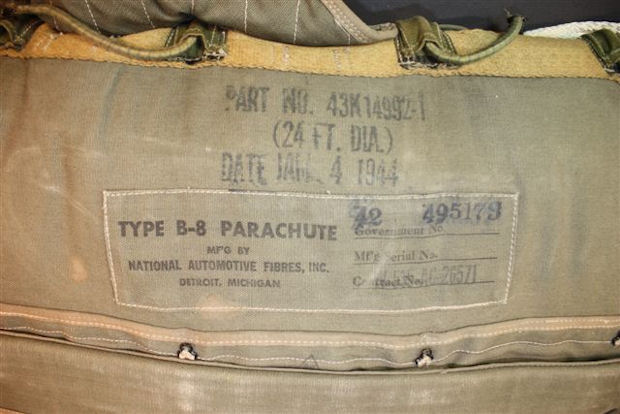
(7-48)
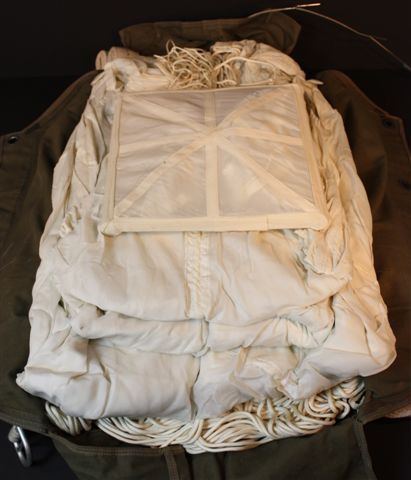
(7-49) Shown above is the B-8 chute with its flaps open. The square pilot chute sits on top.
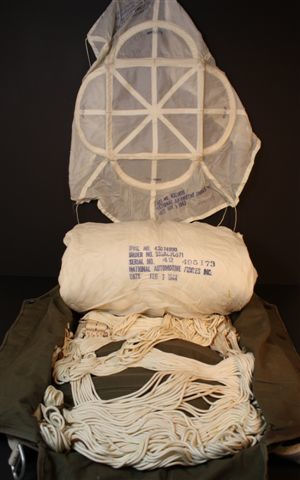
(7-50) Shown above is the parachute date of manufacture February 2, 1944. Also note the serial number on canopy as well as its number applied to the outside bottom flap of the pack. The Pilot chute is dated November 9, 1943. The suspension lines are a mess. The rubber bands that keep the suspension lines packed in their correct order have decomposed.

(7-51) Sorry for the quality of the photograph above. I am not going to waste my money buying a real one. I see people on eBay describing them as harnesses worn by bomber crews in WWII. Yes, some of them have WWII dates on them, and yes, Switlick made all sorts of parachute items, including QACs for the crew during the war. I believe this style shown above was for the civilian market. I have never seen this harness on any 8th AF or 15th AF crewman. You will see it in the 1990s Memphis Belle movie. When it comes to learning about parachute harnesses, do not go by what they wore in the Memphis Belle remake. If you are a beginning collector and you want to collect things that are "kind of" or "sort of" like the real thing, then the harness above is for you.
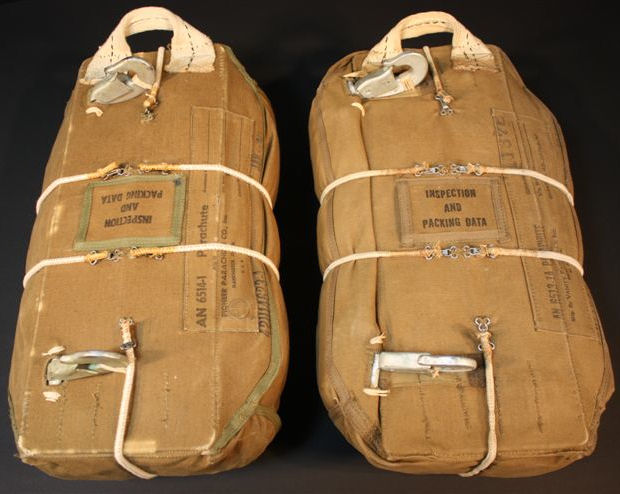
(7-53) Shown above left is the AN-6514-1 QAC parachute made by Pioneer. It is dated Jan. 1943 (no log book). On the right is your typical AN-6513 1A made by Vanity Fair (not previously photographed) dated Aug. 1943. The difference in the two chutes, as best as I can determine, is the arrangement or placement of the two large hooks that connect to the harness. The AN-6513 1A chutes have this odd characteristic after being packed that visually suggest something is not right. It is the way the two large hooks are dealt with. In the 6514-1 variant, it looked like they tried to clean up the design. I have no idea how many 6514-1s are out there or how many were issued, if at all. It is the only one I have come across, so that's all I can share with you for now.
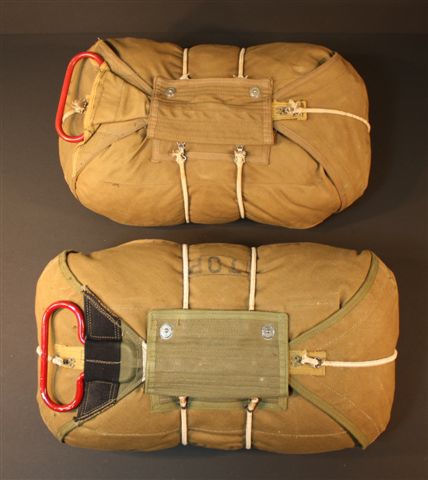
(7-54) .Shown above is the AN-6513 1A on top and the AN-6514-1 below.
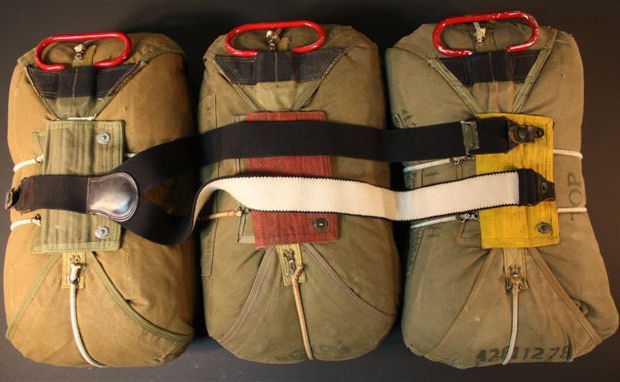
(7-55) On most AN-6513-1A and A-3 parachutes, there will be a piece of black webbing where the rip cord pocket is. This material is the same identical material used to make the early black and white suspenders (like the type used on AAF leather shearling A-3 pants, etc. and F-2 pants.) On the flak vest page, go to photo 6-10. On this particular AN-6513-1A, the rigger has added the webbing with the white side up.
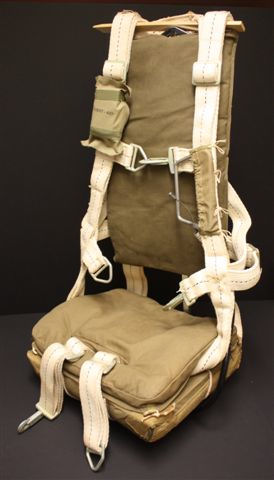
(7-56) vvvvv
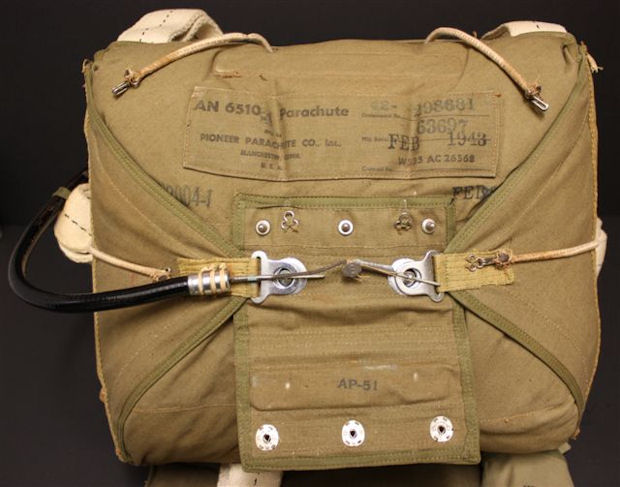
(7-57) vvvvv
| The uniforms and gear presented here are from the private collection of Ed Nored. Any reproduction or other use of these copyrighted photographs is strictly forbidden. 303rdBG.com was granted exclusive rights to these photographs solely for historical purposes. The items shown are not for sale. |
